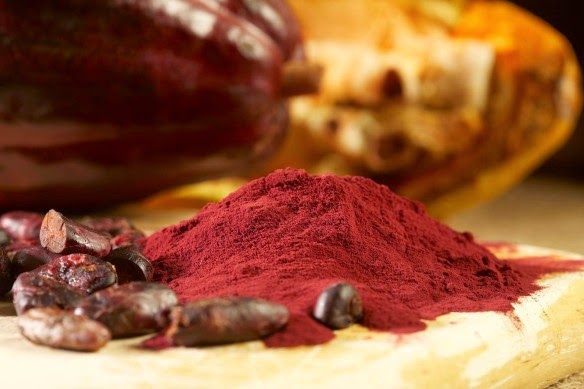Dietary Flavanols Reverse Age-Related Memory Decline
A cocoa flavanol-containing test drink prepared specifically for research purposes was produced by the food company Mars, Incorporated, which also supported the research, using a proprietary process to extract flavanols from cocoa beans. Most methods of processing cocoa remove many of the flavanols found in the raw plant. Image Credit: Mars, Incorporated.
Dietary cocoa flavanols—naturally occurring bioactives found in cocoa—reversed age-related memory decline in healthy older adults, according to a study led by Columbia University Medical Center (CUMC) scientists. The study, published today in the advance online issue of Nature Neuroscience, provides the first direct evidence that one component of age-related memory decline in humans is caused by changes in a specific region of the brain and that this form of memory decline can be improved by a dietary intervention.
Widget not in any sidebars
As people age, they typically show some decline in cognitive abilities, including learning and remembering such things as the names of new acquaintances or where one parked the car or placed one’s keys. This normal age-related memory decline starts in early adulthood but usually does not have any noticeable impact on quality of life until people reach their fifties or sixties. Age-related memory decline is different from the often-devastating memory impairment that occurs with Alzheimer’s, in which a disease process damages and destroys neurons in various parts of the brain, including the memory circuits.
Previous work, including by the laboratory of senior author Scott A. Small, MD, had shown that changes in a specific part of the brain—the dentate gyrus—are associated with age-related memory decline. Until now, however, the evidence in humans showed only a correlational link, not a causal one. To see if the dentate gyrus is the source of age-related memory decline in humans, Dr. Small and his colleagues tested whether compounds called cocoa flavanols can improve the function of this brain region and improve memory. Flavanols extracted from cocoa beans had previously been found to improve neuronal connections in the dentate gyrus of mice.
Dr. Small is the Boris and Rose Katz Professor of Neurology (in the Taub Institute for Research on Alzheimer’s Disease and the Aging Brain, the Sergievsky Center, and the Departments of Radiology and Psychiatry) and director of the Alzheimer’s Disease Research Center in the Taub Institute at CUMC.
A cocoa flavanol-containing test drink prepared specifically for research purposes was produced by the food company Mars, Incorporated, which also partly supported the research, using a proprietary process to extract flavanols from cocoa beans. Most methods of processing cocoa remove many of the flavanols found in the raw plant.
In the CUMC study, 37 healthy volunteers, ages 50 to 69, were randomized to receive either a high-flavanol diet (900 mg of flavanols a day) or a low-flavanol diet (10 mg of flavanols a day) for three months. Brain imaging and memory tests were administered to each participant before and after the study. The brain imaging measured blood volume in the dentate gyrus, a measure of metabolism, and the memory test involved a 20-minute pattern-recognition exercise designed to evaluate a type of memory controlled by the dentate gyrus.
“When we imaged our research subjects’ brains, we found noticeable improvements in the function of the dentate gyrus in those who consumed the high-cocoa-flavanol drink,” said lead author Adam M. Brickman, PhD, associate professor of neuropsychology at the Taub Institute.
The high-flavanol group also performed significantly better on the memory test. “If a participant had the memory of a typical 60-year-old at the beginning of the study, after three months that person on average had the memory of a typical 30- or 40-year-old,” said Dr. Small. He cautioned, however, that the findings need to be replicated in a larger study—which he and his team plan to do.
 Flavanols are also found naturally in tea leaves and in certain fruits and vegetables, but the overall amounts, as well as the specific forms and mixtures, vary widely.
Flavanols are also found naturally in tea leaves and in certain fruits and vegetables, but the overall amounts, as well as the specific forms and mixtures, vary widely.
The precise formulation used in the CUMC study has also been shown to improve cardiovascular health. Brigham and Women’s Hospital in Boston recently announced an NIH-funded study of 18,000 men and women to see whether flavanols can help prevent heart attacks and strokes.
The researchers point out that the product used in the study is not the same as chocolate, and they caution against an increase in chocolate consumption in an attempt to gain this effect.
Two innovations by the investigators made the study possible. One was a new information-processing tool that allows the imaging data to be presented in a single, three-dimensional snapshot, rather than in numerous individual slices. The tool was developed in Dr. Small’s lab by Usman A. Khan, an MD-PhD student in the lab, and Frank A. Provenzano, a biomedical engineering graduate student at Columbia. The other innovation was a modification to a classic neuropsychological test, allowing the researchers to evaluate memory function specifically localized to the dentate gyrus. The revised test was developed by Drs. Brickman and Small.
Besides flavanols, exercise has been shown in previous studies, including those of Dr. Small, to improve memory and dentate gyrus function in younger people. In the current study, the researchers were unable to assess whether exercise had an effect on memory or on dentate gyrus activity. “Since we didn’t reach the intended VO2max (maximal oxygen uptake) target,” said Dr. Small, “we couldn’t evaluate whether exercise was beneficial in this context. This is not to say that exercise is not beneficial for cognition. It may be that older people need more intense exercise to reach VO2max levels that have therapeutic effects.”





